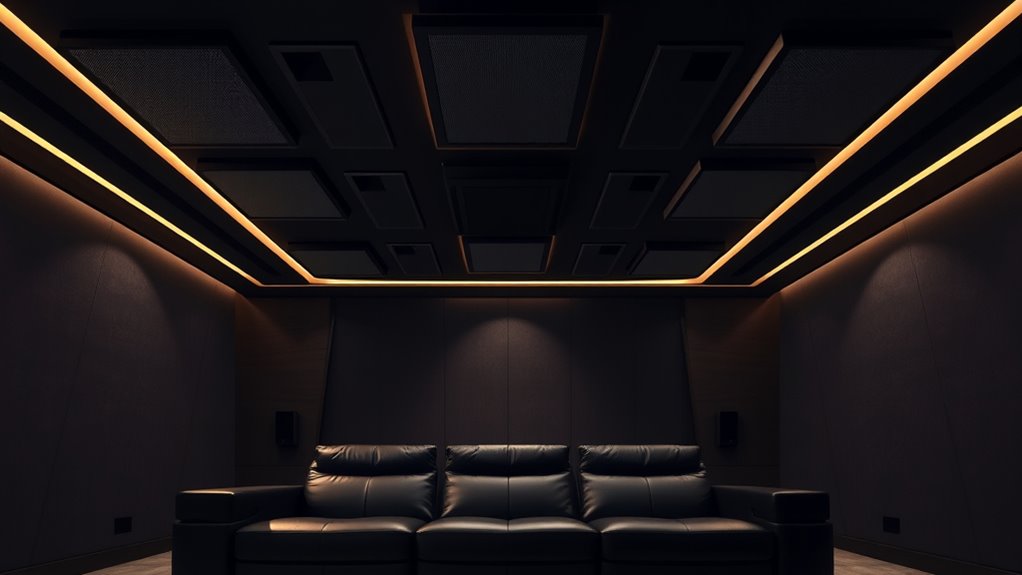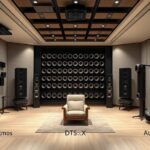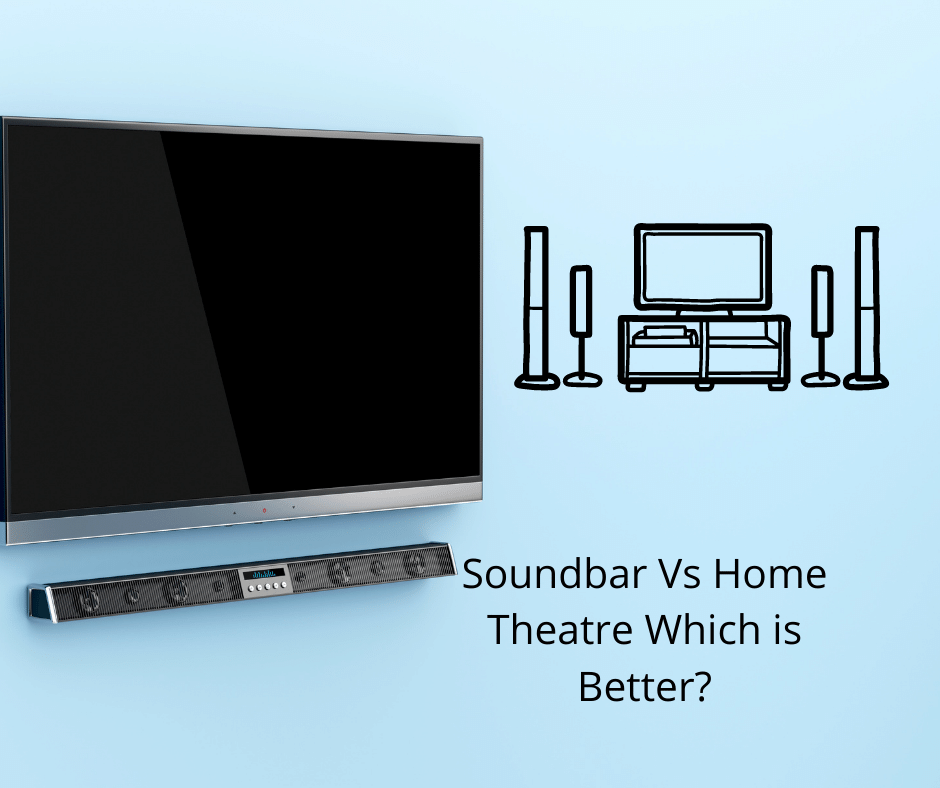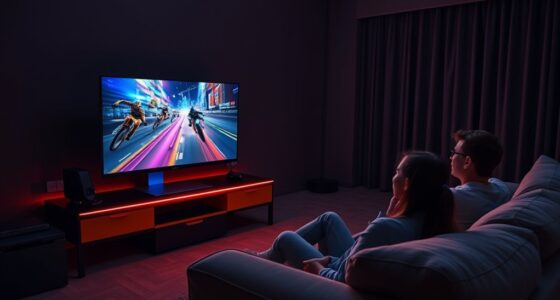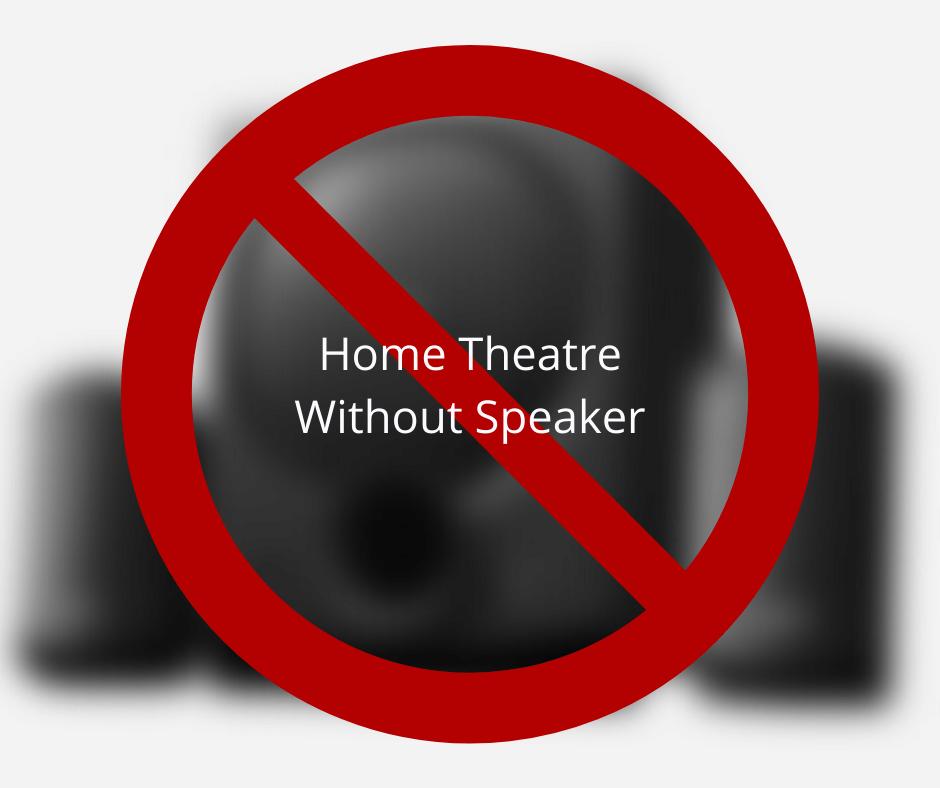Surround sound formats like Dolby Atmos, DTS:X, and Auro‑3D enhance your audio experience by adding height and depth, making sounds appear all around you. These formats go beyond traditional channels, creating immersive environments for movies, music, and more. To achieve this, proper speaker placement and calibration are essential. If you want to discover how these formats work together and improve your home theater setup, keep exploring the details.
Key Takeaways
- Dolby Atmos, DTS:X, and Auro‑3D are advanced surround sound formats that add height and depth for immersive audio experiences.
- These formats extend traditional speaker setups by incorporating overhead or multidimensional sound channels.
- Proper speaker placement, including ceiling or wall-mounted speakers, is essential to maximize their immersive effects.
- Calibration ensures balanced audio, aligning sound effects, dialogue, and ambient sounds across all channels.
- Using these formats enhances realism, making listeners feel inside the action with multidimensional sound movement.

Have you ever wondered how home theater systems deliver immersive sound that surrounds you from all directions? The secret lies in how the speakers are positioned and how the audio is calibrated. Proper speaker placement is essential to create a convincing surround sound experience, especially when dealing with advanced formats like Dolby Atmos, DTS:X, or Auro‑3D. These formats are designed to push sound beyond traditional channels, adding height and depth to your listening environment. When setting up your system, you need to carefully consider where to place speakers—whether on the ceiling, elevated on walls, or at ear level—to maximize the effect. This placement ensures sound moves naturally around you, creating a sense of being inside the action.
Once you’ve arranged your speakers, audio calibration becomes the next critical step. Calibration involves adjusting levels, distances, and equalization to match your room’s acoustics, ensuring each speaker outputs the correct volume and timing. Many home theater receivers include calibration tools—like calibration microphones and auto-tuning software—that analyze your room and optimize speaker settings automatically. This process helps align sound effects and dialogue precisely, so you don’t miss subtle cues or get overwhelmed by loud effects. Accurate calibration guarantees that the surround sound format you’re using, whether Dolby Atmos or DTS:X, performs as intended, delivering a seamless, enveloping experience. Additionally, understanding speaker placement and its impact on sound quality can significantly enhance your listening experience.
Frequently Asked Questions
How Do I Choose the Best Surround Sound Format for My Setup?
To choose the best surround sound format, consider your room acoustics and speaker placement. Dolby Atmos offers immersive overhead sound, ideal if you have space for ceiling speakers or upward-firing options. DTS:X adapts to your setup, providing flexibility. Auro‑3D emphasizes vertical sound layers for a more natural experience. Assess your room’s size and speaker arrangement, then select the format that best complements your space and listening preferences.
Can I Upgrade My Current System to Support Dolby Atmos or DTS:X?
Think of upgrading your system like adding new layers to a cake—you can enhance it without starting from scratch. You can definitely upgrade your current setup to support Dolby Atmos or DTS:X, but you’ll need to check format compatibility and possibly upgrade hardware like your AV receiver or speakers. Most modern receivers support these formats, so a quick hardware upgrade can transform your listening experience into a multi-dimensional adventure.
Do All Movies Support All Surround Sound Formats?
Not all movies support all surround sound formats due to format limitations and content availability. Studios choose specific formats based on production costs and target audiences, so some films may only have Dolby Atmos, while others include DTS:X or Auro-3D. Check the movie’s details before purchasing or streaming to make sure it offers your preferred surround sound format, as compatibility varies across titles.
What Are the Compatibility Requirements for Different Surround Sound Formats?
Think of surround sound compatibility as a key that open a rich audio universe. To make sure your system works seamlessly, you need proper speaker calibration and compatible audio codecs. Different formats like Dolby Atmos or DTS:X require specific speaker setups and compatible hardware. Check your receiver’s specifications and make certain it supports the necessary codecs. Upgrading your equipment or calibrating speakers properly guarantees immersive sound, no matter the format.
Are There Any Cost Differences Between Formats Like Dolby Atmos and Auro-3d?
You’ll find that Dolby Atmos generally has higher costs due to licensing fees and premium content, affecting both hardware and software prices. Auro-3D tends to be more affordable, with lower licensing fees, making it a budget-friendly option. The pricing comparison shows that Atmos might cost more upfront, but it also offers extensive support and content. Consider your budget and desired features when choosing between these formats.
Conclusion
By now, you see how Dolby Atmos, DTS:X, and Auro-3D elevate your audio experience. Did you know that over 70% of new home theaters now support at least one of these formats? This shows how immersive sound is becoming more mainstream, transforming how you enjoy movies and music. As technology advances, you’ll find even richer, more realistic soundscapes, making every moment feel like you’re right there in the action.
